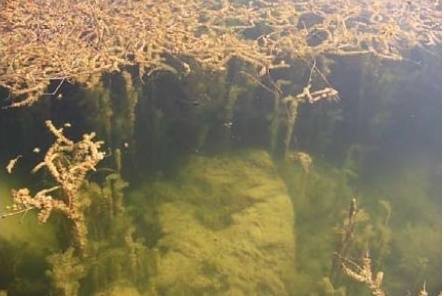Those thick mats of vegetation floating just below the surface of Lake Sammamish are more than a nuisance to boaters and a danger to swimmers — they’re also the perfect camouflage for predatory fish to hide out as they wait for young salmon to swim by.
These invasive plants are Eurasian Milfoil, and were introduced to the U.S. in the early 1900s before eventually spreading to Lake Washington in the 1970s. Since then, they’ve spread throughout the lake. The plant reproduces rapidly, and even a tiny segment left in the water is enough for it to regrow.
The thick mats also provide perfect cover for non-native game fish like large and small mouth bass and yellow perch as they wait to gobble up juvenile salmon on their migration route.
For years, the invasive milfoil plant was thought to be too difficult to manage, said David Kyle, Lake Sammamish Kokanee Restoration Project Manager with Trout Unlimited. But a new project Kyle is leading will see if there’s a way to remove the plants.
“I think it’s a great showcase of how the county and nonprofits and government agencies can work together to look at finding solutions to our salmon problems,” Kyle said.
The plan involves contracting with Seascapes NW to use divers to suction up the milfoil. The technique pulls up the plant and root and brings it to the surface where it’s collected. The program will treat five, 75-meter-long sites around Lake Sammamish bordering public access like parks. Afterward, they plan on letting the areas settle for a few weeks, after which divers will go out and look at fish abundance in the treated areas versus non-treated areas to see if the milfoil removal is effective at clearing out non-native game fish.
The Muckleshoot Indian Tribe is also doing a fish population study, and agreed to share data on some of their sample sites in the lake. It will help Kyle and his team determine whether there’s a corresponding increase in non-native game fish in areas of the lake that haven’t been treated for milfoil.
King County is providing some $50,000 for the project, said Perry Falcone, Kokanee Recovery Manager for the county, which was supported heavily by King County Councilmember Claudia Balducci.
The county conducted a study two years ago in Lake Sammamish that found non-native fish outnumbered native fish by a count of three to one.
“The concern is that these other fish are predators or competitors with kokanee salmon or other salmon species,” Falcone said.
Many salmon species across Washington state have been declining for decades. In Lake Sammamish, a unique variety of freshwater kokanee salmon that never heads out to sea has seen its population plummet over the past decade, raising serious fears of extinction.
This launched a massive restoration effort between the Snoqualmie Tribe, King County and many other organizations under the Kokanee Work Group. Predation is one of a number of factors thought to be contributing to the decline.
If it’s found that non-native fish are using milfoil, the treatment could be expanded. Falcone said removing milfoil would also benefit boaters, swimmers and water quality. If everything goes as planned, the treatment will be conducted in June and results posted by the end of summer.



